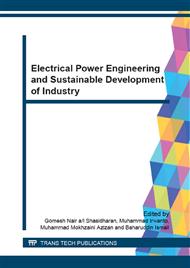[1]
Tian Peizhe, Zhang Enxiang, Li Chunwang, and Sun Yuying, Study on the Control Strategy and Algorithm of Cooling Source Based on Cooling on Demand in Intelligent Building Management, Information Management, Innovation Management and Industrial Engineering International Conference, IEEE, 2009, pp.202-205.
DOI: 10.1109/iciii.2009.358
Google Scholar
[2]
Noriomi Okazaki, KunioMizutani, and Haeyoung KIM, Research on simulation of coupled dynamic model of air conditioning system, 11th ICROS Korea, Oct 2011, pp.1467-1469.
Google Scholar
[3]
James Piper: Chillers, the Elements of Energy Efficiency, August 2004, http/www. facilitiesnet. com/hvac.
Google Scholar
[4]
Kun Deng, Yu Sun, Amit Chakraborty, Yan Lu, Jack Brouwer, and Prashant G. Mehta, Optimal Scheduling of Chiller Plant with Thermal Energy Storage using Mixed Integer Linear Programming, American Control Conference (ACC) Washington, DC, USA, June 17-19, 2013, pp.2958-2963.
DOI: 10.1109/acc.2013.6580284
Google Scholar
[5]
Yung-Chung, Jui-Kun Lin, and Meng-Hsuan, Optimal chiller loading by genetic algorithm for reducing energy consumption, Energy and Buildings, vol. 37, p.147 – 155, (2005).
DOI: 10.1016/j.enbuild.2004.06.002
Google Scholar
[6]
A.I. Dounis, M. Santamouris, and C.C. Lefas: Building Visual Comfort Control with Fuzzy Reasoning, Energy Conversion and Management, Vol. 34, 1993, pp.17-28.
DOI: 10.1016/0196-8904(93)90004-t
Google Scholar
[7]
A.I. Dounis, M. Santamouris, C.C. Lefas, and A. Argiriou: Design of A Fuzzy Set Environment Comfort System, Energy and Buildings, Vol. 22, 1995, pp.81-87.
DOI: 10.1016/0378-7788(94)00902-v
Google Scholar
[8]
Zazilah May, Nursyrizal Mohd Nor, and Kamaruzaman Jusoff, Optimal operation of Chiller System using Fuzzy Control, Recent Research in Artificial Intelligence, pp.109-115, (2011).
Google Scholar
[9]
R. J. Dossat: Principles of Refrigeration, New York, Wiley, (1991).
Google Scholar
[10]
S. N. Sivanandam, S. Sumathi and S. N. Deepa: Introduction to Fuzzy Logic using MATLAB, © Springer-Verlag Berlin Heidelberg, (2007).
DOI: 10.1007/978-3-540-35781-0
Google Scholar
[11]
Guanrong Chen Trung Tat Pham: Introduction to Fuzzy sets, Fuzzy logic, and Fuzzy control system, CRC Press London, NewYork Washington, D.C., © (2001).
Google Scholar
[12]
Water-cooled screw chiller Service manual on http: /www. btmalta. com/user_files/13/water-cooled-screw-chiller-service-manual. pdf.
Google Scholar


